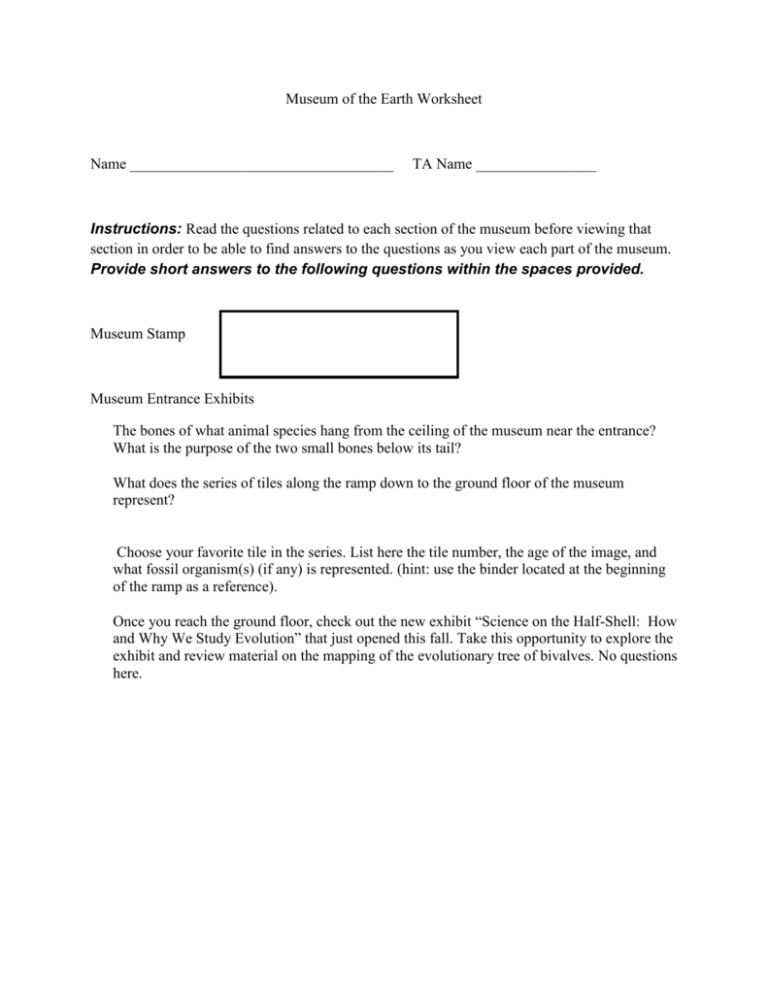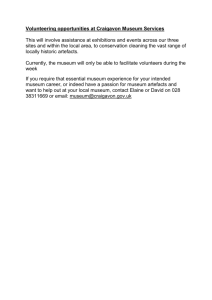Worksheet for the Museum of the Earth
advertisement

Museum of the Earth Worksheet Name ___________________________________ TA Name ________________ Instructions: Read the questions related to each section of the museum before viewing that section in order to be able to find answers to the questions as you view each part of the museum. Provide short answers to the following questions within the spaces provided. Museum Stamp Museum Entrance Exhibits The bones of what animal species hang from the ceiling of the museum near the entrance? What is the purpose of the two small bones below its tail? What does the series of tiles along the ramp down to the ground floor of the museum represent? Choose your favorite tile in the series. List here the tile number, the age of the image, and what fossil organism(s) (if any) is represented. (hint: use the binder located at the beginning of the ramp as a reference). Once you reach the ground floor, check out the new exhibit “Science on the Half-Shell: How and Why We Study Evolution” that just opened this fall. Take this opportunity to explore the exhibit and review material on the mapping of the evolutionary tree of bivalves. No questions here. Once you are on the ground floor, most of the museum exhibits are arranged chronologically, beginning at the Earth’s formation 4.6 billion years ago and ending with the present time. As you walk through, notice the timelines on the wall that map your current location in Earth’s history. Arrows along the wall direct you through each exhibit in the correct time sequence. Pay attention to the short films as well as physical exhibits in many rooms, as you may find clues in both. Enjoy the museum! Precambrian (4,600 - 545 million years ago) *Watch the video on this period! What unique physical conditions of this planet allowed life to prosper? In the Precambrian, eukaryotes evolved into multicellular forms from their microscopic unicellular ancestors. How do we know single-celled organisms were the first to exist so long ago? When did multicellular organisms first appear? What novel adaptations did the evolution of multicellularity allow? Cambrian, Ordovician, Silurian (545 - 410 million years ago) What was the Cambrian explosion and what might have caused it? What is the official New York State Fossil and during what geologic period was it common? Are fossils in general common or uncommon in New York? Why? (You may want to return to this question at the end of your visit.) Devonian (410 - 355 million years ago) “The Age of Fishes” List 5 major characteristics that developed during the evolution of fishes in the Devonian period. Although these characteristics are not present in all descendant lineages, one was of particular importance to the later evolution of animal groups such as amphibians, reptiles, birds, and mammals like ourselves; which one? The evolution of modern vascular plants from non-vascular plants (like mosses) occurred by the Devonian Period. What characteristics evolved in vascular plants that allowed them to live more efficiently on land? Carboniferous, Permian, Early Triassic (355 - 205 million years ago) What important type of fossil lets us infer changes in sea level in the past and why? How is the abundance of plant life during the Carboniferous Period linked to industrialization of human civilization much later in the Quaternary Period? “How Evolution Works” Room Check out this room, in particular the interactive natural selection computer game and the video about one of our own lecturers for the class, Dr. Amy McCune and her research on fossil fish. If you like this topic, you might think about taking Dr. McCune’s popular upperlevel macroevolution class offered at Cornell. Her course gives a much more in-depth treatment of this topic than we cover in BioEE 1780. No questions here. Jurassic, Cretaceous, Tertiary (205 - 1.8 million years ago) How might the diversification of flowering plants in the Cretaceous have favored the diversification of insects, and vice versa? Take a look at the Archaeopteryx fossil from the Jurassic Period. What hypothesis about the evolution of birds was supported by the discovery of this fossil? What traits seen in this fossil support this hypothesis and why? Quaternary Period (1.8 million years ago - today) When did the most recent ice age end? Behavior can be inferred from fossils! Examine the mastodon and mammoth remains from the Quaternary Period found in central New York. What difference between these two related species can scientists infer by examining their teeth? Extinction display Mass extinctions are defined as when over 60% of living species become extinct across the plant in a relatively short span of time (a few million years). In addition to the well-known mass extinction of the dinosaurs, how many other mass extinctions have there been? What was the most severe extinction and what percentage of species went extinct then? What is the cause of the most recent extinction? Consider the enormity of geologic time: Modern humans (Homo sapiens) have existed for about 200,000 years. What percentage is this of the total time since the first unicellular life appeared on Earth? Overall, in your opinion what do you think is the most important thing students should get out of visiting the Museum of the Earth?






